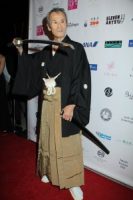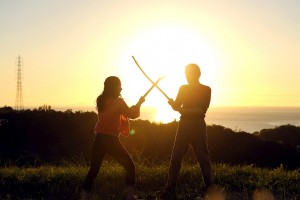By: Izumi Hasegawa December 5, 2014

attention to me, this one newspaper interviewed me and wanted to come up with something to impact readers by saying how many tens of thousands of roles I had played. While a lot of them are in movies, once TV series got big there were tons of shows going on at once. Every week I’d have about six shows to shoot, and it wouldn’t be sword fighting every time either. When you have roles like that over the decades, which is a really long time, that really adds up. The newspaper decided to calculate it and say that I had been in about 20,000 roles. Eventually that kind of became my catchphrase and over time, people started adding more and somehow it became 50,000 times. I really don’t think it’s that great a number though.
 Q: How did you make so many roles?
Q: How did you make so many roles?
In the morning you were a samurai, in the afternoon a detective, and then next I was a yakuza member, then a government official, and so on. Each day was like a daily special. Sometimes I’d have to get killed once, then run behind the camera, and get killed again. So in one cut I got killed two or three times. When it comes to television, the amount of people that you need isn’t few at all. For one minute, there can be from 15 to 20 kirareyaku around the scene. In a single cut like that, you get 10 people that get killed. In movies they use different people so that you don’t notice, but in TV they would use the same person over and over. And one time will be a kill looking back, and another some other way all to get a certain image.
 Q: What did you discover playing a leading role?
Q: What did you discover playing a leading role?
I didn’t discover anything, I kept getting shy all the time. Up until now, I’ve never been the lead, I’ve always been a kirareyaku. I kept saying, “Please stop calling me a lead actor all of a sudden.” We’re all part of Tsurugi-Kai (swordsman association) and use the same common area. But I realized that they gave me special treatment, but I told them I was still just like everyone else. The director treated me with lots of respect, but I’m not different from anybody. I was really taken aback. Getting in front of the shot was the first time I did, so I thought, “Eh? What do I do?” I couldn’t pay attention to acting because of it. So I thought I was going to mess it up, but then I remembered what legendary director Kinji Fukasaku told me a long time ago. “In a movie, it’s not just about the lead actor. Everyone that acts around the lead gets their moments. Sometimes those people around the lead act, they all become the lead.” So I thought, “That’s right. I’m not the only lead actor.” Once I thought about that, I was able to relax a little bit.
 Q: What do you do for training or preparation of Kirareyaku?
Q: What do you do for training or preparation of Kirareyaku?
The aesthetics of the kirareyaku, that is the aesthetic of dying, is about making the lead look better through the way we die and making him think it was worth it, is what I think. That’s why, in our own way, we shine as well. If we do it properly, we can shine even greater than that, and so can the lead. But it’s not like we’re not there for the sake of making the lead shine. In that moment where we fight the lead one on one, we shine together. That is how I feel and have been doing it. That is when the lead can shine — when we do our job correctly and fall at the hands of the hero.
Q: What is fun about Kirareyaku?
I think the number one thing is being able to lie. When you act like you’re dying, that is the biggest lie of all, though I say it hesitantly. You must be able to lie perfectly. You have to die as if your clothes are being torn and go “Wah!” with your eyes going crazy. You have to try various things. Acting like you’re dying is pretty tough. Even though I’ve done it for 50 years, when I think about it enough, it’s just hard. I try various ways by imagining how the audience will view it. In the end, that doesn’t work out, so I go back to the original plan. But even now I think that it’s still really difficult. There’s no real right way though, no single answer. No matter what you do, it depends on how the viewers see you. That’s what I think.
 Q: What message do you give to young people?
Q: What message do you give to young people?
It’s not something that is given to you. It’s something that you have to achieve yourself. You need to realize by yourself, “Didn’t I get this from my senior?” or “I got this from that one star, right?” Realize that the things that you have are really things taken from someone else. That’s why I don’t tell others what my sword fighting or choreography is like, but instead I tell them, “Steal it!” Back then, we looked at the good parts and the bad parts from our seniors and the stars before and by observing them, we learn ourselves. That is how we’ve always done it — not copy them, but to make it your own with adding of yours. That’s how I hope that they will pass it on to the next generation. When I was young, it took years to be able to be close to the camera, be seen. But TV is different. It is easy to be able to be close to the camera and be seen. There are many more chances for young people to act, to be seen. But despite that, I find myself wondering why they don’t try harder to take them. I don’t think I’m really saying that, because I don’t have that chance, but compared to my time, there are more amazing chances. They need to be more ambitious about it. Our seniors back in the day would tell me, “Hey! Stay out of my way!” and get angry. But I want them to be more aggressive in pushing their way forward.
Uzumasa Limelight is in theaters December 5th.
